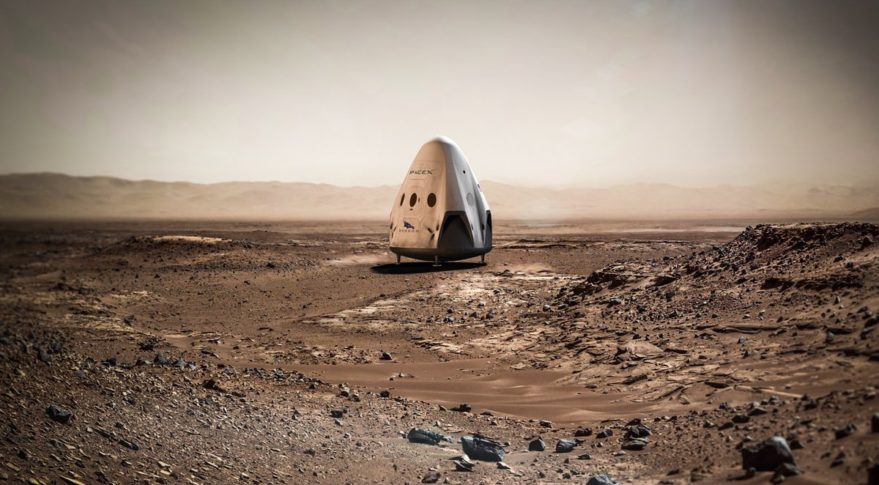SpaceX Estimated to Spend $300 Million on Red Dragon Mars Mission

WASHINGTON — NASA estimates that SpaceX is spending on the order of $300 million on its Red Dragon Mars lander mission, a down payment on the company’s long-term ambitions for human Mars missions.
At a meeting of the NASA Advisory Council's technology committee in Cleveland July 26, Jim Reuter, deputy associate administrator for programs in NASA's space technology mission directorate, provided an overview of NASA's agreement with SpaceX, announced in April, to support that company's plans for an uncrewed Mars landing mission that could launch as soon as May 2018.
That agreement, in the form of an unfunded Space Act Agreement, does not include any exchange of funds between NASA and SpaceX. Reuter said NASA estimates it will spend approximately $32 million over four years, primarily in the form of NASA personnel providing technical support for SpaceX. About $6 million of that will be spent this fiscal year, he added. [SpaceX's Red Dragon: A Private Mars in Pictures]
Asked by the committee how much SpaceX was spending, Reuter indicated that the company's investment was 10 times that of NASA. "They did talk to us about a 10-to-1 arrangement in terms of cost: theirs 10, ours 1," he said. "I think that's in the ballpark.” Given NASA’s investment, that implies SpaceX is spending around $300 million on Red Dragon.
SpaceX has not disclosed its estimated cost of the mission, or how it will pay for it. "I have no knowledge" of how the company is financing the mission, Reuter said when asked by the committee.
Reuter also provided some additional technical details about the mission. The Red Dragon spacecraft, launched on a Falcon Heavy, will be based on the Crew Dragon spacecraft SpaceX is developing for NASA's commercial crew program. Much of the capsule’s interior will be stripped out, including displays and environmental controls not needed for the mission. The unpressurized trunk section attached to the capsule will have “more substantial” modifications, he said, primarily in the form of solar array placement and thermal controls.
NASA is providing expertise in several areas to support the Red Dragon mission. The agency has already provided landing site selection advice and engineering support, he said. Other support ranges from consultation on planetary protection protocols for the mission to the use of the Deep Space Network for communications with the spacecraft.
Get the Space.com Newsletter
Breaking space news, the latest updates on rocket launches, skywatching events and more!
NASA made this investment into supporting Red Dragon because it concluded the mission appeared feasible. "We determined there was a reasonable likelihood of their concept being a successful mission," he said. "We thought our expertise would enhance that."
In return, NASA will gain access to data SpaceX collects during its landing attempt, which will use a technique called supersonic retropropulsion that the agency has identified as a key means to allow the landing of larger spacecraft on the surface of Mars. While NASA has landed spacecraft weighing about one ton on Mars, Reuter said Red Dragon will weigh 8 to 10 tons at landing.
An alternative to Red Dragon, Reuter suggested, would be for NASA to fly its own technology demonstration mission to show how well supersonic retropropulsion works. "In this case, it would be the late 2020s or early 2030s" before such a mission would fly, he said. Data from Red Dragon could come a decade sooner and help inform NASA decisions expected around 2020 on its architecture for human Mars missions.
That assumes, however, that Red Dragon will launch as planned in May 2018, something Reuter sounded skeptical about. "That's an extremely aggressive schedule,” he said. The agreement with SpaceX, he said, does include milestones to allow NASA to judge how well the company is sticking to that schedule, starting with a "system mission discussion" near the end of this year.
Reuter said that SpaceX has indicated that its Red Dragon work is a lower priority for the company than its other missions for paying customers. "Their first priority is ISS crew, the next priority is to meet all their other commitments for launch services," he said. "This comes after that."
Red Dragon is, for SpaceX, only the first in a series of missions as part of the company's long-term plans for human expeditions to, and settlement of, Mars. Elon Musk, the founder and chief executive of SpaceX, said at a conference last month that he plans to send missions on "every Mars opportunity from 2018 onwards," a reference to the launch windows that open every 26 months.
The first human mission, Musk said then, could launch as soon as 2024, landing on Mars in 2025. Musk plans to disclose details about his Mars mission architecture in a September presentation at the International Astronautical Congress in Guadalajara, Mexico.
Reuter said there have been no talks with SpaceX about any NASA role on the company’s Mars plans beyond cooperation on Red Dragon. "We've not had any discussions at all with them on that," he said.
This story was provided by SpaceNews, dedicated to covering all aspects of the space industry.
Join our Space Forums to keep talking space on the latest missions, night sky and more! And if you have a news tip, correction or comment, let us know at: community@space.com.

Jeff Foust is a Senior Staff Writer at SpaceNews, a space industry news magazine and website, where he writes about space policy, commercial spaceflight and other aerospace industry topics. Jeff has a Ph.D. in planetary sciences from the Massachusetts Institute of Technology and earned a bachelor's degree in geophysics and planetary science from the California Institute of Technology. You can see Jeff's latest projects by following him on Twitter.









